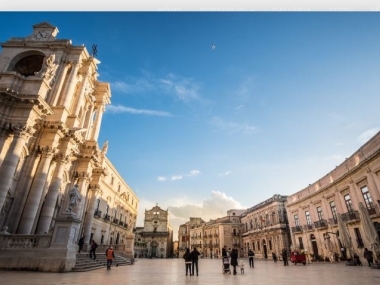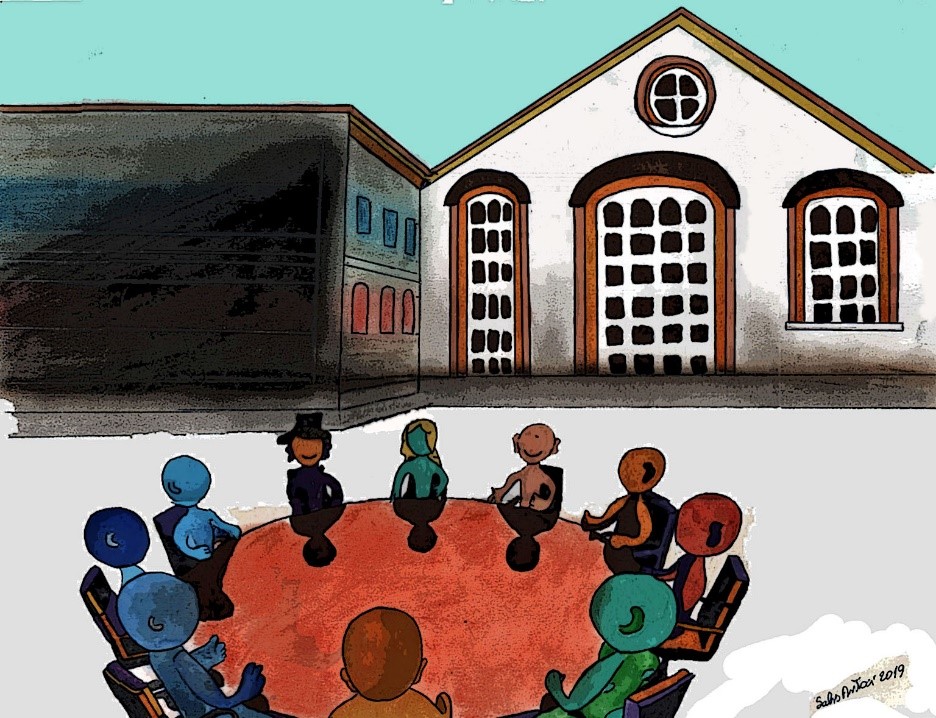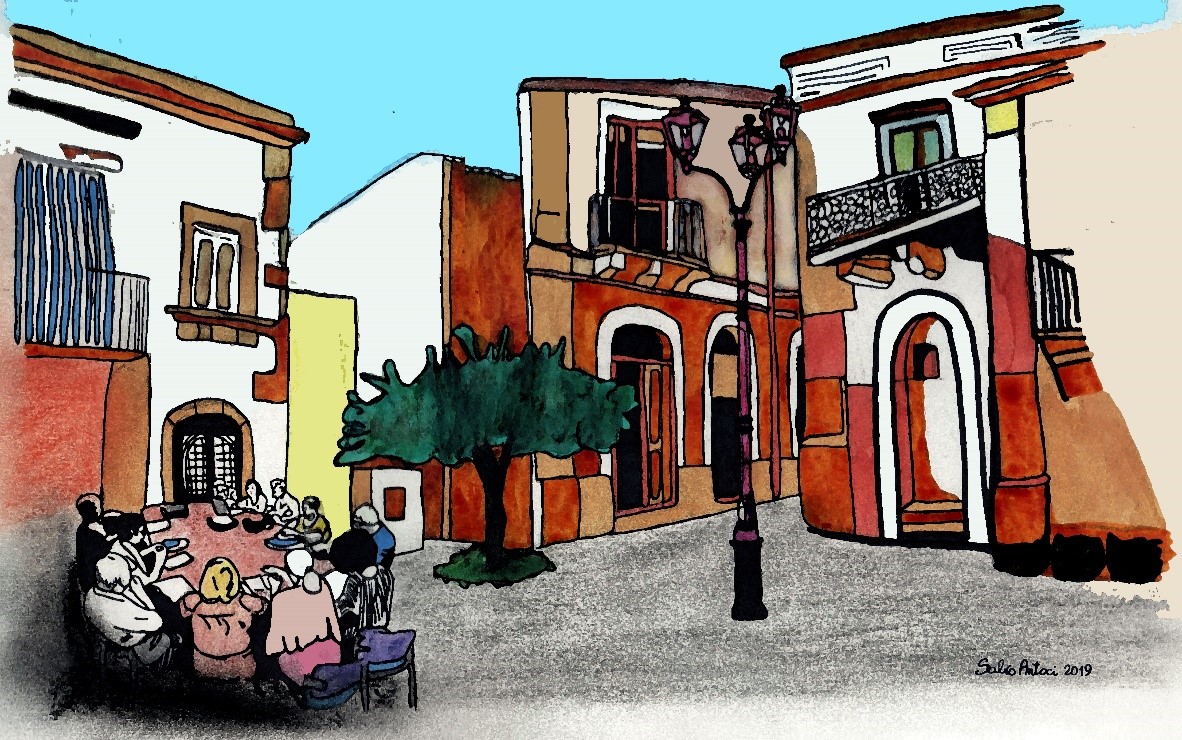Learning cities, the value of cooperation. Transfer Story from Syracuse
Edited on
28 April 2021It was a spring morning and I was cycling via Malta to Ortigia when I saw a beautiful building, clearly a work of industrial archaeology, and I wondered what it was about. I had recently moved to Syracuse and everything was new and waiting to be discovered. The building was not yet open to the public, but the person I asked for information told me that it was the Urban Center, a recovered space to become an innovative interface between administration and community, a space open to the city, where citizens can explore urban, environmental and social policies, a place for promotion, sharing, planning, socialization. I have a vivid memory of the emotion I felt admiring the building and listening to this passionate and visionary story. I imagined a social and cultural ferment, a physical place where people, stories, needs, experiences, knowledge, projects, activities meet to design together a new way of living the city.

Two years later, when I started working for the ACTive NGOs project, I remembered myself, on my bicycle, listening and imagining the Urban Center. Suddenly I felt energised and joyful to give my contribution to the challenge that the city of Syracuse was facing with its third participation in the European URBACT programme in the transfer of the good practice of Riga: to enhance the potential of citizens’ ideas and skills and to develop the collaboration between the municipality and third sector associations.
Public-private cooperation and civic involvement are important issues for many European cities in urban development. Sharing resources and responsibilities between municipalities and civil society can help create processes of co-designing urban spaces and services, thus active participation in city life.
*********
The city of Syracuse is facing some problems. The recent austerity measures imposed on the administration and the consequent cuts in public budgets have led to the inefficiency of some social services. The municipality wants to address this situation also by creating innovative synergies with different social and economic actors and involving NGOs to ensure services and social inclusion to all citizens, especially the most disadvantaged groups.
NGOs need a better "hard" and "soft" system: physical spaces to carry out recreational, cultural and social activities, training courses, services to citizens; knowledge and skills to face social challenges.
And again, the municipality has had several difficulties in carrying out some projects related to three public spaces, between experiences that have been interrupted, such as the Citizen's House in a disadvantaged neighbourhood, and very promising and important initiatives, such as those of Officine Giovani in the historic centre of Ortigia and the Urban Center in a very central location, which still have great potential to express.
The challenges that the municipal administration of Syracuse is facing seem to echo the problems faced by the NGO House in Riga, and have prompted Syracuse to look with interest at the experience of the Latvian city.
Riga and Syracuse very different cities, how can one be useful for the other? What kind of relationship has been created?
It is true, they are different cities, but they share some things: they are learning to make the most of energy from below to create synergies between NGOs, citizens and institutions.
They are both beautiful cities with good practice of civic-public cooperation, their historical centres are both UNESCO World Heritage Site, they are both seaside cities.
Unlike a provincial city like Syracuse, Riga is a capital city that performs the functions of political direction for the whole nation, has many structures and specialized staff.
Riga is a model to understand how to create and manage cooperation between NGOs and institutions.
“Nothing truly valuable can be achieved except by the unselfish cooperation of many individuals” says Albert Einstein and Syracuse have a lot to learn from Riga in the path towards social inclusion and improved services to all citizens.
**********
The idea of the NGO House in Riga was born in 2010 as a possible model of cooperation between citizens, NGOs and local municipalities, to solve communication problems and respond to the NGO's lack of meeting spaces and activities.
The Riga City Council established the NGO House in September 2013 to address the challenges of participation in the activities of the municipality and social integration for people of different ages, social groups and nationalities, to support NGOs and promote citizens' awareness of local affairs.
It serves as a platform for cooperation between non-governmental organizations and the municipality, providing a space where organizations develop cooperation with the municipality, receive educational, technical, administrative and information support, organize events, discuss and address current societal issues and challenges.
The solutions offered by the Riga good practice are oriented towards the creation of a democratic and inclusive society based on solidarity, sustainability and equal access to civil, social, economic and cultural rights.

The NGO House of Riga
How can this good example be reused and adapted in Syracuse to provide practical support to NGOs and involve citizens in addressing the various current challenges?
The city's NGOs need meeting spaces and activities and have few opportunities for collaboration with the municipality.
The city is receptive and ready to put into practice processes of cooperation with civil society.
Thanks to the Open Pilot Transfer Network Urbact GeniUSiracusa, an Open Innovation process has been experimented with good results in communication and collaboration between NGOs and the municipality, leading to the co-design of the Citizens' House, a participatory space realized in an abandoned floor of a public school.
The NGO House in Riga inspired us because it worked to solve the problem of active participation and cooperation between NGOs and citizens.
We were surprised by the practice in Riga as a political will turned the idea of opening the NGO House into reality and we were intrigued of how much the public administration has invested by providing a large structure and a dedicated staff; a fairly top-down approach that has led to great results.
Thanks to the initial meetings in Riga and to the URBACT methodology based on facilitation and comparison, we understood how to adapt the Good Practice to our context. In Syracuse it was not possible to provide for the involvement of financial and human resources made available in Riga, but we could count on an active local support group, partly already experienced with the Citizen's House, ready to collaborate by providing energy and human resources and to participate in the management.
Syracuse’s challenge has therefore become to develop a more open and inclusive governance model and offering NGOs opportunities for empowerment.
Within ACTive NGOs, locally led by the "Policy Sector for City Relations and Innovation", the challenges of Syracuse found some solutions in the transfer, adopting and adapting the Riga Good Practice.
Since the municipality does not have the financial and human resources to fully take care of the management of the three spaces, while NGOs need spaces to carry out their activities and improve their skills, there is a need to improve collaboration between NGOs and the administration; therefore a more open and inclusive model of governance has been sought and developed, which is opening up as opportunities for learning, growth and collaboration for both organisations and the municipality.
The transfer process is focused on the creation of a network of collaboration between the associations and a network of three civic spaces provided by the municipality, on the co-design of their identity and institutional vision and on participatory events to test their model of functioning.
The spaces, connected as the House of Associations and Volunteers (following the example of Riga), have different characteristics and possibilities of use.

The most interesting and humanly motivating part of the transfer process, which is able to create generative wealth, is the shared and mutual learning, thanks to the methodology of exchange and comparison and cooperation between cities. Methodologies, tools and knowledge have been shared into the network and become useful for all cities.
This also contributes to the enrichment of the Good Practice path proposed by the Lead Partner. In other words, in the Good Practice transfer path it is not only the 'receiving' cities that learn but also the 'giving city'.
****************
Aristotle said: “What we have to learn to do, we learn by doing”.
It is essential to practice a skill in order to become proficient at it. This is especially true with cooperation.
We have taken learning and inspiration not only from the example of Riga but also from the partner cities during the transnational meetings.
In Santa Pola we understood how useful the topic of “mapping” is, a starting point and an effective tool also in the long term, and this allowed us to build on and develop an ongoing project.
In Dubrovnik we had confirmation that a public administration can use its physical resources to create strategic locations and channel different funding, which was very inspirational, despite the diversity of context.
The ongoing discussion with colleagues in Brighton has inspired us for all those recreational activities (morning coffee, football matches, etc.) which are fundamental both for the ULG's commitment and for the activities with the residents and which we want to start with the opening of the Houses.
In the comparison between peers it was equally useful to be able to stimulate the other partners in their path.
Salvo Antoci, one of the stakeholders of ACTive NGOs tells his experience:
“ACTive NGOs is the third URBACT project in which I participate and it is the one that has most strengthened the mutual knowledge and the connection with the other participating associations.
The good practice of Riga has made us reflect and work to achieve a similar result in our city. Thanks to local and transnational meetings I've experienced what cohesion and exchange means, for the first time I got to grips with the realities of the other partner cities and was aware that I was a European citizen,
committed to a purpose that goes beyond the idea of our city.
I was commissioned to document the various phases of the project with a diary, I tried to do so with the means most congenial to me: photography and drawing.

The ability to collaborate effectively between associations and with municipality has found its best result in the co-design of the Governance Model of the House of Associations and Volunteers.
This demonstrates that we have incorporated the example of the NGO House and that we have pursued final objectives more suited to the local context. In fact, Syracuse has taken advantage of the mistakes made in the past with the House of Citizens and wanted to involve from the beginning all stakeholders in sharing the drafting of the protocol.
It’s a process of learning and empowerment both of NGOs and municipality.
The municipality is learning the new role of supervisor of a social innovation project, it is increasing an attentive and inclusive city leadership that listens to the needs of all citizens, in particular the most disadvantaged groups.
“We are understanding how important it is to dedicate an exclusive structure to manage the coordination between associations and manage the community centres” says Nunzio Marino, the ACTive NGOs project manager for the Municipality of Syracuse.
“We are learning to listen to the needs that come from the bottom up and incorporate them into public programs and activities.”
NGOs are acquiring a lot of knowledge and skills.
For the first time many NGOs have had to engage in participatory governance models that brings together public and private in a new and effective synergy, they are protagonists in the co-design of complex management and communication models in order to shape the management model and write the governance agreement of the new House of Associations and Volunteers.

We are learning that involving citizens to civic challenges frees up energy and skills, makes them feel like actors for change. It is exciting and inspiring.
We are learning how the mapping of needs, activities, missions is useful to increase the mutual knowledge and encourage collaboration and synergy. To do it we are learning to use a digital system map solution, ‘Guidabile’, a data collection app based on community-generated content, developed to digitize the association mapping process.
We are obtaining communication skills: how to effectively communicate during meetings, increasing listen and mutual understanding in order to collaborate more effectively, how to improve the use of online communication, thanks to the activation of social network (whatsapp group) and media (facebook pages) and newsletter. This ability to use digital technologies to collaborate is crucial in this period of lockdown caused by the Covid-19 emergency, it’s a concrete proof of the skills acquired.
We are learning that leisure activities are useful to involve stakeholders.
All this learning is useful today to carry on the co-management of the House of Associations and Volunteers and will be even more relevant in the future for the challenges of Welfare.
****************
An important step in the transfer process was the signature of the Protocol of Understanding, which was the result of a shared writing between the NGO and the municipality, by the Mayor and 27 active organizations. An important signature because it officially sanctioned the birth of the House of Associations and Volunteers, a long-awaited signature delayed due to the difficulties arising from the lockdown and the period of health emergency due to Covid-19 which slowed down the final procedures. Now the House has its governing bodies and is working out innovative ideas and solutions to celebrate the House’s opening to citizens, taking into account the limits due to the anti-Covid restrictions.
The transfer process of the Best Practice to Syracuse is moving on, it’s too early to say if it's a complete success. We are learning many useful skills and we are understanding many difficulties and gaps.
In order to ensure continuity of dialogue between NGOs and institutions, a team could perhaps be set up to deal specifically with this issue.
What we still have to learn in Syracuse is to bridge the gap between institutions and volunteering, to implement a social inclusion strategy that foresees a systematic involvement of citizens and associations. The results of the project in Syracuse are mainly based on the good will of some actors but the cooperation is not yet structured to effectively change the nature of services provided to the city.
We want to continue to acquire all the knowledge and skills useful to better manage the new scenario that opens before us, in which the third sector will play a key role in the implementation of urban policies.
Author: Nancy Russo
Illustrations: Salvo Antoci
 Submitted by z.biteniece on
Submitted by z.biteniece on
